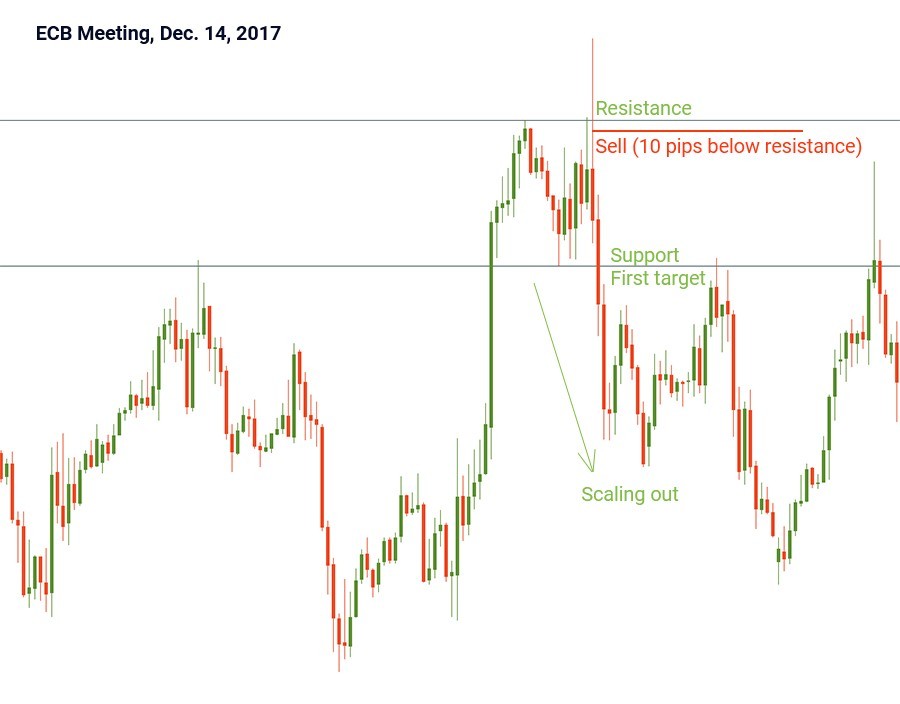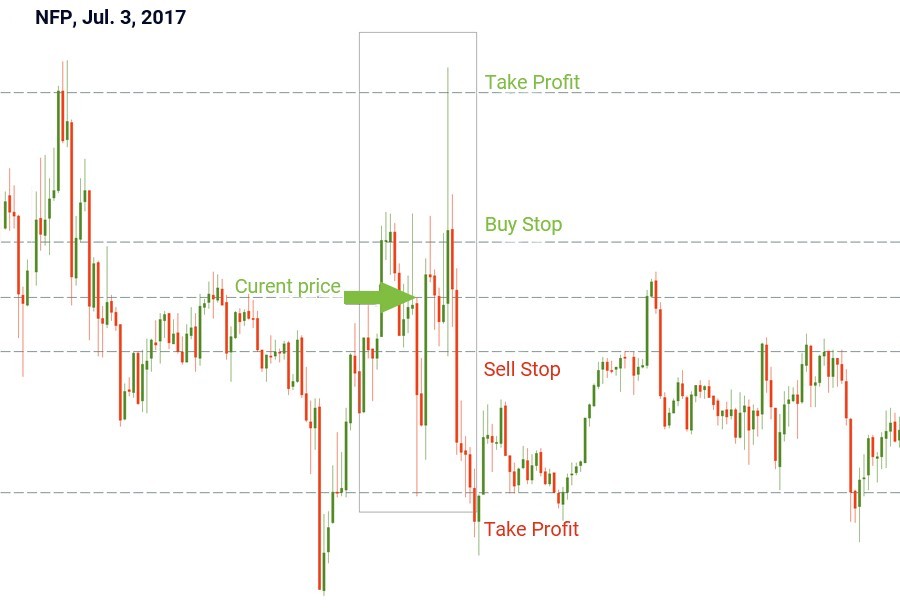Devisenhandel Nachrichten
Informationen sind keine Investitionsberatung
Nachrichten darstellen große Gewinnchancen für Devisenhändler. Unter Nachrichten verstehen wir verschiedene wirtschaftliche Veröffentlichungen. Jede große Volkwirtschaft veröffentlich regelmäßig Statistiken wir BIP, Inflation, Arbeitslosenrate usw. Wenn Sie Forex während zu den Zeiten der Veröffentlichungen handeln, haben Sie eine Chance viel zu verdienen.
Aber möchten wir Sie warnen, dass mögliche große Gewinne immer zusammen mit größeren Risiken kommen. Volatilität sinkt während dieser Zeiträume und der Kurs kann ungeordnet bewegen. Wenn Sie keinen soliden Handelsplan für bestimmtes Ereignis haben, ist es besser überhaupt nicht zu handeln.
In diesem Tutorial lichten wir Handel mit Nachrichten und wirtschaftlichen Veröffentlichungen. Es gibt verschiedene Strategien, die man benutzen kann.
Wie liest man den Wirtschaftskalender
Die Märkte berücksichtigen die zukünftigen Zeitperioden. Als Erfahrungsregel bedeutet Wirtschaftswachstum zukünftigen Wohlstand, der einer Verstärkung der Landeswährung gleichkommt. Händler suchen den Aufwärtstrend in der Wirtschaft (positive wirtschaftliche Veröffentlichungen), weil er gute Möglichkeiten öffnet. Im Gegenteil, wenn wirtschaftliche Veröffentlichungen eine Flaute im Wirtschaftswachstum zeigen, bedeutet es die Schwächung für die Landeswährung. Also wird der zukünftige Währungswert bestimmt, basierend darauf, ob die aktuelle Daten der Prognose entsprechen, sie übersteigen oder nicht.
Ein Wirtschaftskalender ist ein wichtiges Instrument, das den Händlern wichtige Ereignisse nicht zu verpassen hilft. Seine Struktur ist einfach. Wirtschaftliche Indikatoren sind in einer Tabelle für einen gewählten Zeitraum aufgelistet. Neben einem Indikator kann man drei Datenspalten sehen: frühere Anzeige, Prognose und aktuelle Anzeige. Vor der Veröffentlichung enthält der Kalender nur die vorherige Anzeige und die Prognose. Die aktuelle Anzeige erscheint zum Zeitpunkt der Veröffentlichung.
Die Prognose ist eine sogenannte "Konsensus"-Prognose oder, mit anderen Worten, der Median von Schätzungen vieler Experten, Marktanalysten, die vor der Veröffentlichung befragt wurden. Wenn die aktuelle Anzeige besser als die Prognose ist, wertet die Währung auf. Wenn schlechter, wertet die Währung ab. In den meisten Fällen, "besser" bedeutet höher als Prognose und "schlechter" - niedriger. Es gibt verschiedene Ausnahmen für die Regel, wie Arbeitslosenrate: je niedriger der Indikator, desto besser für eine betreffende Währung. Wir sollten auch beachten, dass eine Zahl, die neben dem prognostizierten Level ist, in der Regel vernachlässigbare Auswirkung hat. Je größer die Divergenz zwischen der aktuellen und der prognostizierten Zahl, desto größer ist die Auswirkung auf den Markt.
Vorherige Anzeige ist nicht so wichtig wie die prognostizierte. Manchmal wird die vorherige Anzeige überarbeitet. Man überarbeitet sie, wenn die aktuelle Anzeige veröffentlicht wird. Wenn die Überarbeitung wesentlich ist, wird sie zur Wirkung der Nachrichten beiträgt.
Wichtige Tipps
- Konzentrieren Sie sich auf die wichtigsten Nachrichten, die die größte Auswirkung für den Markt haben könnten.
- Warten Sie auf die gewählte Veröffentlichung und dann handeln nach dem Plan.
- Denken Sie daran, dass die Marktreaktion in der Regel von 30 Minuten bis zu 2 Stunden dauert.
- Wenn Ihre Logik und technische Analyse scheitern und die Marktreaktion auf die Nachrichten Ihren Erwartungen nicht entsprechen, handeln Sie nicht gegen den Markt. Folgen Sie dem Markttrend (vielleicht verpassten Sie einige wichtige Details in Ihrer Analyse oder interpretierten die Auswirkung der Veröffentlichung falsch).
- Eilen Sie nicht. Warten Sie auf wirklich starke Signale und ihre Bestätigung.
Und jetzt betrachten wir drei Strategien, die man für Handel mit Nachrichten verwenden kann.
Schleuder-Strategie
Wenn Sie in einem sehr volatilen Markt handeln,.
Um eine Position zu öffnen, bestimmen Sie Unterstützung und Widerstand. Da sind Ihre "Trennpunkte": man kann die Position auf diesen Ebenen schließen, wenn Kurs gegen Sie geht. Autoren der Strategie empfehlen, Stop-Loss-Abstand vor der Veröffentlichung des Nachrichtenberichts zu bestimmen. Um die Risiken während der volatilen Periode der Presseveröffentlichungen zu reduzieren, kann man das folgende machen: wenn Sie auf dem H1 Chart bemerken, dass der Kurs 10 Pips unter der Unterstützung ist, stellen Sie einen BUY-STOP-Entry Order 10 Pips über dem Niveau. So kann man bei der Marktumkehrung nach einem anfänglichen Swing.
Gleich mit einer Short-Position: wenn Sie auf dem H1 Chart bemerken, dass der Kurs 10 Pips über der Unterstützung ist, stellen Sie einen SELL-STOP-Entry Order 10 Pips unter dem Niveau.
Die Schleuder-Strategie versucht Gewinnpositionen aufzubauen, wenn der Handel zu Gunsten der Händler bewegt. Wenn der Kurs zu Ihren Gunsten geht, aber Sie sind nicht sicher, wie lange daeuert diese Bewegeung, kann man. Wenn der Kurs weiter in die gleiche Richtung bewegt, kann man die gleiche Prozedur auf weiteren Ebenen durchführen.

Handel mit Erwartungen: das Gerücht kaufen, Fakt verkaufen
Die Idee ist sehr einfach: man sollte die Marktstimmung im Verhältnis zu einer bestimmter Währung verstehen und eine Position entsprechend der Stimmung öffnen. Es gibt kurzfristige und langfristige Marktstimmungen. Viele Händler bevorzugen Handel während kurzer Zeiträume, weil sie nicht genügend Gelder haben, um offene Positionen in Zeiten der höhen Volatilität zu erhalten.
Kurzfristige Stimmung wird durch wirtschaftliche Nachrichten bestimmt. Wenn Marktteilnehmer erwarten, dass die Daten die Konsensprognose übersteigen, berücksichtigen sie das. Zum Beispiel, wenn Marktteilnehmer warten, dass die Zentralbank Australiens ihre Zinse erhöht, steigt der Wechselkurs des AUD vor der Sitzung der Bank (die möglichen Zinsanhebungen werden bis zur aktuellen RBA Sitzung berücksichtigt). Wenn die RBA ihren Zins erhöhte, die Marktteilnehmer, die bereit für solche Wendung waren, würden wahrscheinlich AUD/USD handeln und das Paar würde wirklich sinken und nicht steigen nach der Zinsanhebung.
Um finanziell besser gestellt in solcher Situation zu sein, sollte man:
- Auf dem Laufenden über die kommenden Ereignisse und wirtschaftliche Veröffentlichungen sein.
- Über die aktuellen Veröffentlichungen den Überblick behalten und auf die Marktreaktion achten.
- Die Korrelation zwischen verschiedenen Veröffentlichungen (zum Beispiel, wie Einzelhandelsumsatz kann BIP, PPI, CPI beeinflussen; wenn Einzelhandelsumsatz vor Erwartungen geht, kann man auf starke BIP-Veröffentlichung warten).
Handelssteigerung
Man kann diese Strategie verwenden, wenn Sie mit sehr wichtigen Nachrichten oder wirtschaftlichen Veröffentlichungen handeln, wie NFP (Non-Farm Payrolls). Es ist einer der wichtigsten einflussreichen Statistikkennzeichen, das durch das Bureau of Labor Statistics veröffentlicht wird. Es misst die Zahl der Arbeitsplätze des nichtlandwirtschaftlichen Sektors in den US in einem Monat. NFP wird am ersten Freitag jedes Monats veröffentlicht.
Nfp kann viele Schockwellen für die technischen Charts bringen. Darum warten viele Händler darauf, dass der Staub sich setzt (sie eilen nicht sofort nach der Veröffentlichung zu handeln) und handeln, wenn sie eine bessere Vorstellung von der Wirkung der Veröffentlichung haben.
Ihre Handlungen vor der Veröffentlichung: sehen Sie die Reihe an, in der das Paar zum jetzigen Zeitpunkt handelt wird, dann stellen Sie in 5 Minuten vor der Veröffentlichung zwei ausstehende Aufträge (BUY STOP - 20 Pips über dem aktuellen Kurs und SELL STOP - 20 Pips unter dem aktuellen Kurs).
Stellen Sie Take Profit Aufträge in 40 Pips oberhalb und unterhalb des aktuellen Kurses. Sie können Stop Loss zum aktuellen Kurs in 5 Minuten vor der Veröffentlichung stellen oder überhaupt nicht stellen. Bei einem positiven Ergebnis kann man das Geschäft mit Gewinn schließen (vergessen Sie nicht anderen Auftrag zu schließen). Wenn Sie glücklich sind, kann man bei beiden Ihren Wetten verdienen (wenn der Kurs seine Richtung ändert und wird höher/niedriger vor dem Fall/Steigen).
Wenn das Ergebnis negativ ist, bewegt der Kurs in eine Richtung, aktivieren den ersten Auftrag, aber bringen nicht den Gewinn. Dann bewegt der Kurs in die Gegenrichtung, öffnen anderen Auftrag, aber auch bringen keinen Gewinn. Wenn Sie Stop haben, werden Ihre Verluste begrenzt. Wenn Sie Stops bei Ihrem Einsstieg nicht stellen, kann man Ihre Verluste mit neuen Aufträgen zu ersethen, obwohl die Risiken in solchem Fall sich erhöhen.

Andere Artikel in dieser Sektion
- Struktur eines Handelsroboters
- Einen Handelsroboter ohne Programmierung bauen
- Wie man Handelsroboter im MetaTrader5 benutzt?
- Algorithmischer Handel: Was ist das?
- Algo-Handel mit MQL5
- Was bedeutet "Trunkierung"?
- Ichimoku
- Führendes Diagonalmuster
- Wolfe-Wellen-Muster
- Three-Drives-Muster
- Hai
- Schmetterling
- Crab
- Bat
- Gartley
- ABCD
- Harmonische Muster
- Motiv- und Korrekturwellen. Wellengrade
- Einführung in die Elliott-Wellen-Analyse
- Wie man Breakouts handelt
- Wie kann man einen Take Profit aufgeben?
- Risikomanagement
- Wie vergibt man einen Stop-Loss-Auftrag?
- Techische Indikatoren: Handel-Divergenzen
- Ichimoku Kinko Hyo














